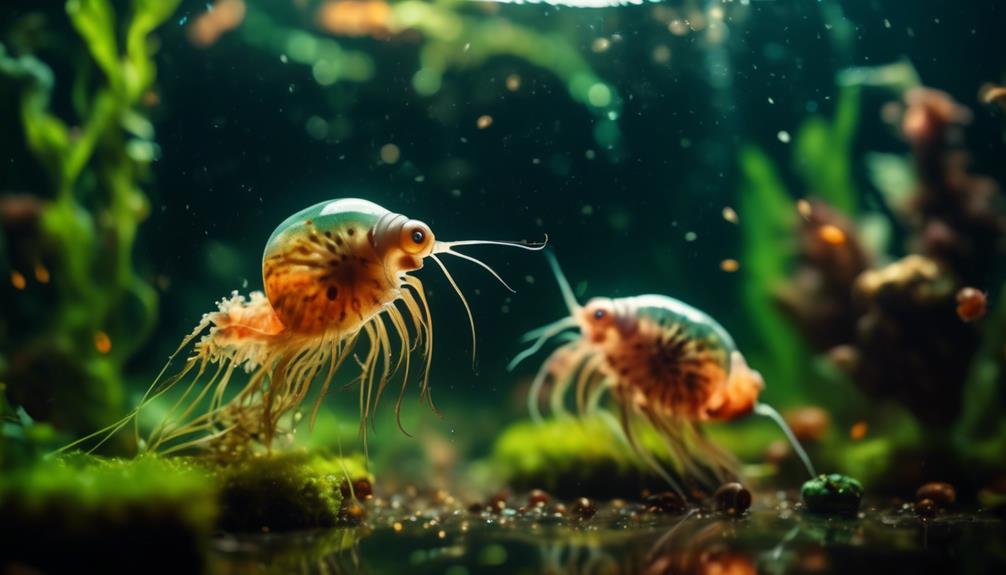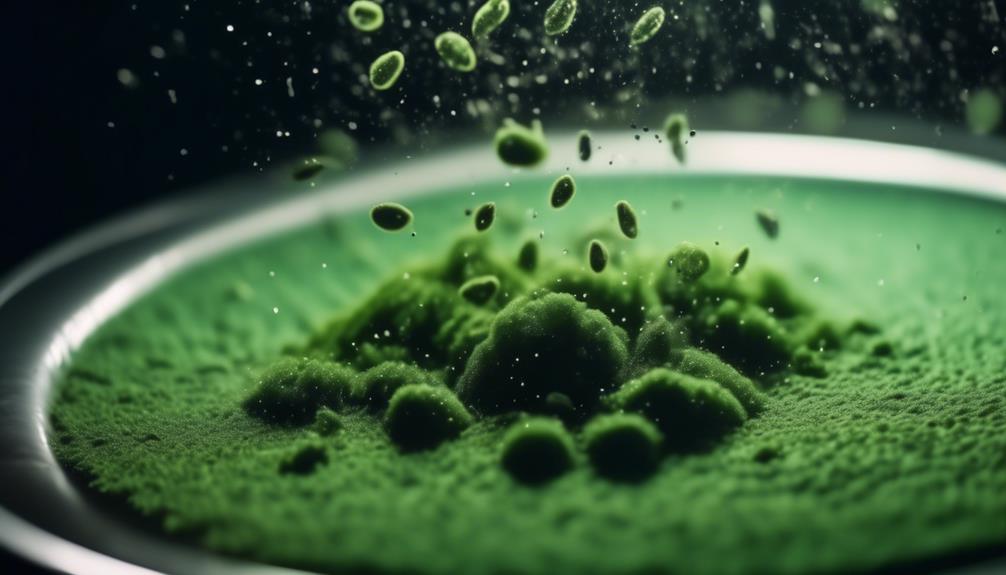Did you know that Daphnia, also known as water fleas, can be a mesmerizing addition to your aquarium? These delicate organisms have a unique ability to thrive in the right conditions, providing a captivating sight for any observer.
But what are the secrets to maintaining a thriving Daphnia tank? How do you create the ideal environment for these tiny creatures to flourish?
In this article, we will uncover the answers to these questions and more, revealing the key factors that will unlock the secrets to a successful Daphnia tank.
So, prepare to uncover the mysteries and uncover the secrets that will transform your aquarium into a haven for these fascinating organisms.
Key Takeaways
- Choose a tank with greater surface area than depth and maintain a water temperature of around 68 degrees Fahrenheit to mimic Daphnia's natural habitat.
- Keep the Daphnia tank indoors to avoid temperature fluctuations and prevent the growth of mosquito larvae and invasion of other species.
- Add freshwater shrimp and snails to the tank to clean up debris and contribute to the overall ecosystem, but choose species that do not prey on Daphnia.
- Feed Daphnia with active dry yeast, spirulina powder, and cultivate green plants in the tank to provide them with sufficient food. Harvest Daphnia frequently to prevent population crashes and benefit the existing population.
Tank Setup and Maintenance
To set up and maintain your Daphnia tank, begin by selecting a tank that provides a greater surface area than depth to mimic their natural habitat. This design promotes better oxygen exchange and helps create a suitable environment for your Daphnia.
Additionally, ensure proper tank filtration to maintain water quality. Invest in a reliable filtration system that efficiently removes waste and debris, preventing the accumulation of harmful substances.
It's also crucial to monitor and maintain the water temperature. Aim for a temperature around 68 degrees Fahrenheit, as this is the ideal range for Daphnia. Fluctuations in temperature can stress and harm these organisms. Regularly check and adjust the water temperature to ensure their well-being and overall health in the tank.
Indoor Vs. Outdoor Tanks
Indoor tanks are generally recommended over outdoor tanks for keeping Daphnia due to their ability to maintain a stable temperature and prevent the introduction of unwanted species. Factors to consider when choosing between indoor and outdoor Daphnia tanks include the following:
- Temperature stability: Indoor tanks provide better control over temperature, ensuring that Daphnia aren't exposed to extreme fluctuations that can negatively impact their health and reproduction.
- Species invasion: Outdoor tanks may be susceptible to the invasion of unwanted species such as copepods or mosquito larvae, which can disrupt the balance of the Daphnia tank ecosystem. Indoor tanks help prevent such invasions.
- Aeration and water quality: Aeration is crucial for Daphnia tanks to improve yield and maintain water quality. Indoor tanks can be equipped with aeration systems more easily, promoting optimal conditions for Daphnia.
- Space availability: The size of the tank and available space should be considered when choosing between indoor and outdoor setups. Indoor tanks can be more easily accommodated in limited spaces, while outdoor tanks require suitable outdoor areas.
Consider these factors when deciding between indoor and outdoor Daphnia tanks to ensure the best conditions for thriving Daphnia populations.
The Role of Shrimp and Snails

When considering the optimal conditions for thriving Daphnia populations, it's important to understand the significant role that shrimp and snails play in the overall ecosystem of the tank. Adding freshwater shrimp and snails to the tank can provide numerous benefits.
These organisms contribute to the cleanliness of the tank by cleaning up debris and microscopic particles, helping to maintain water quality. Shrimp and snails also help control the growth of algae by consuming excess nutrients.
However, it's crucial to manage the populations of shrimp and snails to prevent them from preying on the Daphnia. In larger tanks with a high Daphnia population, shrimp and snails can be particularly beneficial. It's necessary to add them in appropriate numbers to maintain balance and avoid overpopulation.
Debunking Daphnia Tank Myths
Contrary to popular belief, green water isn't necessary for the thriving of Daphnia in a tank. In fact, maintaining clear water can be beneficial for their health and overall well-being.
Here are four myths about Daphnia tanks that need to be debunked:
- Green water isn't necessary: Daphnia are excellent water cleaners and can thrive in clear water. They feed on microscopic particles and help maintain water quality.
- Daphnia population control: While Daphnia reproduce rapidly, it's essential to monitor their population to prevent overcrowding. Regular harvesting and maintaining a balanced ecosystem can help control their numbers.
- Daphnia tank diseases: Contrary to popular belief, Daphnia are relatively resistant to diseases. However, maintaining proper water conditions, avoiding overcrowding, and regular water changes are crucial to prevent any potential health issues.
- Smaller tanks aren't sufficient: Daphnia produce a significant amount of waste, which can lead to water quality issues in smaller tanks. It's recommended to choose larger tanks to handle the waste and maintain a stable environment for Daphnia.
Feeding and Harvesting Daphnia

Maintaining a proper feeding and harvesting routine is crucial for the successful cultivation of Daphnia in your tank ecosystem. Feeding frequency depends on the clarity of the water, so it is important to feed them when the water is clear. Daphnia can be fed active dry yeast, which is mixed with water to activate the cultures. Spirulina powder, known as an algae superfood, can also be added to their diet. Cultivating green plants such as algae in the tank is beneficial as Daphnia can consume them as well. Feeding times make Daphnia more active and visible, enhancing the overall experience of observing and serving these tiny organisms.
| Feeding Frequency | Algae Cultivation |
|---|---|
| Clear Water | Active Dry Yeast |
| Spirulina Powder | |
| Algae |
Frequently Asked Questions
What Is the Ideal Tank Size for Keeping Daphnia?
The ideal tank size for keeping Daphnia depends on the desired population and available space. Larger tanks, ranging from 5 to 360 gallons, provide more room for growth and prevent population crashes.
Can Daphnia Survive in an Outdoor Tank?
Yes, Daphnia can survive in an outdoor tank. Outdoor tanks offer benefits such as natural sunlight and access to live food sources. Optimal conditions include maintaining temperature, preventing predators, and ensuring proper aeration.
Do Shrimp and Snails Prey on Daphnia?
Shrimp and snails can prey on Daphnia, but choosing species that don't eat them is crucial. Implement population control strategies like adding shrimp and snails in appropriate numbers to maintain balance and benefit the tank ecosystem.
How Long Do Daphnia Live?
Daphnia have a short life cycle, lasting only a few months. Factors affecting their lifespan include water quality, temperature, and food availability. Maintaining optimal conditions in the tank can help maximize their lifespan.
What Is the Best Method for Harvesting Daphnia Without Harming Them?
To harvest Daphnia without harm, gently scoop them with a fine mesh net from the water surface, avoiding sudden movements. Transfer them directly to a fish tank or separate container. Frequent harvesting helps with population management.
Conclusion
In conclusion, unlocking the secrets to maintaining a thriving Daphnia tank can be compared to unraveling a delicate puzzle. By carefully selecting the right tank size and location, understanding the importance of freshwater plants, and considering the role of shrimp and snails, you can create an ideal environment for these fascinating organisms.
Debunking common myths and mastering feeding and harvesting techniques will ensure the health and longevity of your Daphnia population. Get ready to embark on a captivating journey and witness the beauty of these tiny aquatic creatures in your own home.

